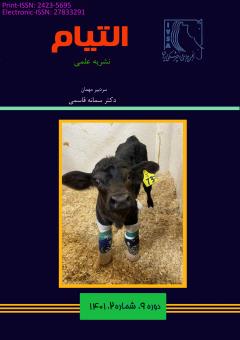مدیریت شکستگی ها در گاو
محورهای موضوعی : Veterinary Soft and Hard Tissue Surgeryنسیم قائمی فر 1 , فائزه علی پور 2
1 - دانشگاه فردوسی مشهد
2 - -
کلید واژه: شکستگی, گاو, تثبیت داخلی, تثبیت خارجی,
چکیده مقاله :
وقوع شکستگی های استخوانی یکی از مشکلاتی است که امروزه به کرات در حیوانات رخ می دهد و می تواند آسیب های زیادی را سبب شود. این پدیده به صورت معمول در نشخوارکنندگان از جمله گاو ها بسیار رایج می باشد که این گونه حیوانات اصولا انتخاب های خوبی جهت انجام عمل جراحی در جهت اصلاح شکستگی و بهبود پس از آن می باشند. به طور کلی شکستگی هایی که در نشخوارکنندگان و عموما در دام های بزرگ رخ می دهد از اهمیت بالایی جهت درمان برخوردار هستند زیرا طبق تجربیات با وجود هزینه ای که صرف می شود، درمان این عوارض نتیجه های خوبی را ارائه داده است. شکستگی ها بیشتر اندام های حرکتی خلفی و قدامی حیوانات را درگیر کرده و موارد کمتری از قسمت های دیگر گزارش شده است. انتخاب روش مناسب درمان و کنترل این عوارض تحت تاثیر عوامل متعددی قرار می گیرد اما به صورت کلی عوامل اقتصادی در بیماران می تواند یکی از موثر ترین فاکتور ها جهت انتخاب استراتژی درمانی و کنترلی مناسب تلقی شود. در زمینه اصول مدیریت شکستگی ها مواردی چون توجه به معاینه فیزیکی، جلوگیری از عفونت های ثانویه بعدی و ... قرار می گیرد. به طور کلی از سال 1950 به بعد، استفاده از تثبیت داخلی در درمان شکستگی ها روند افزایشی گرفت. هزینه هایی که جهت تهیه ابزار های تثبیت داخلی شکستگی ها , تهیه عکس های رادیوگراف، دستمزد جراحان , مراقبت های بعد از عمل و … صرف می شود شاید برای صاحب دام قابل توجه باشد به همین علت بایستی قبل از شروع عمل جراحی این مسائل با صاحب دام در میان گذاشته شود. در خصوص اصلاح شکستگی ها با تثبیت خارجی با وجود این که مطالعات زیادی در خصوص استفاده از این روش وجود دارد اما در خصوص استفاده از این سیستم در حیوانات بزرگ مطالعات زیادی در دسترس نیست. در این مقاله به اصول درمان شکستگی ها از نوع تثبیت داخلی و خارجی اشاره شده است.
Today, bone fracture is one of the common problems that can occur in animals and can cause many damages. Fracture is common in ruminants including cattle, these animals are generally considered as good candidates to perform surgical operations in order to correct fracture and recovery. Generally, fractures which occur in ruminants and generally in large ruminants are of great importance for treatment because according to experiences, despite the cost incurred, the treatment of these complications is a good result .Often fractures occur in hind limb and fore limb parts of the animals and fewer cases are reported from the other parts. Selection of appropriate treatment method and control of these complications is affected by several factors, but in general, economic factors in patients can be considered as one of the most effective factors in this selection. About fracture management, some factors such as physical examination, prevention of subsequent secondary infection and etc, are discussed. In general, from 1950 onwards, the use of internal fixation in the treatment of fractures increased. The costs that are used to provide internal fixation instruments, preparation of radiographs, the salary of surgeons, postoperative cares and etc, may be considered for the owner, therefore, it should be considered before the beginning of surgery. Although there are many studies about the modification of fractures with external fixation, but there is a little data about the use of this system in large animals. In this article, the principles of treatment of internal and external fixation fractures are mentioned.
1. Adams S. B. (1985). The role of external fixation and emergency fracture management in bovine orthopedics. The Veterinary clinics of North America. Food animal practice, 1(1), 109–129.
2. Pentecost, R., Niehaus, A. J., & Anderson, D. E. (2016). Surgical Management of Fractures and Tendons. The Veterinary clinics of North America. Food animal practice, 32(3), 797–811.
3. Jean, G. S., & Anderson, D. E. (2014). Decision analysis for fracture management in cattle. Veterinary clinics: food animal practice, 30(1), 1-10.
4. Nichols, S., Anderson, D. E., Miesner, M. D., & Newman, K. D. (2010). Femoral diaphysis fractures in cattle: 26 cases (1994–2005). Australian veterinary journal, 88(1‐2), 39-44.
5. Anderson, D. E., & Jean, G. S. (2008). Management of fractures in field settings. Veterinary Clinics of North America: Food Animal Practice, 24(3), 567-582.
6. Vogel, S. R., & Anderson, D. E. (2014). External skeletal fixation of fractures in cattle. Veterinary Clinics: Food Animal Practice, 30(1), 127-142.
7. Nuss, K. (2014). Plates, pins, and interlocking nails. Veterinary Clinics: Food Animal Practice, 30(1), 91-126.
8. Dubey, P., Aithal, H. P., Kinjavdekar, P., Amarpal, G. P., & Nanjappa, M. D. A Comparative In Vitro Biomechanical Investigation of a Novel Bilateral Linear Fixator vs. Circular and Multiplanar Epoxy-Pin External Fixation Systems Using a Fracture Model in Buffalo Metacarpal Bone. World J Surg Surgical Res. 2021; 4, 1331.


